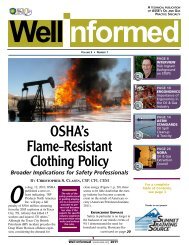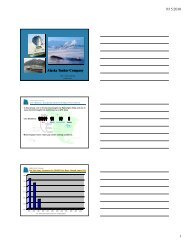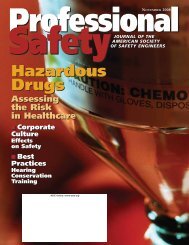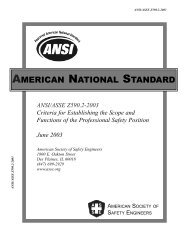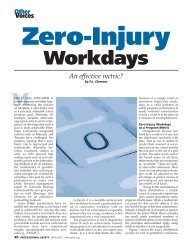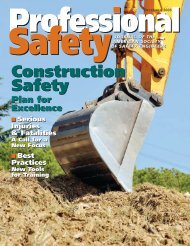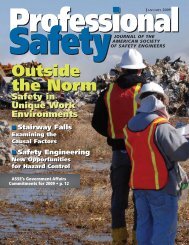Safety 2008 - ASSE - American Society of Safety Engineers
Safety 2008 - ASSE - American Society of Safety Engineers
Safety 2008 - ASSE - American Society of Safety Engineers
Create successful ePaper yourself
Turn your PDF publications into a flip-book with our unique Google optimized e-Paper software.
site’s environmental conditions and the impact theyhave on the required scope <strong>of</strong> work.For example, soil and groundwater remediationmay be required. The site disposition options mayinclude “cold/warm hold”; decontamination anddemolition to slab; complete decontamination anddemolition with site restoration; or no action based onthe findings <strong>of</strong> this phase (see “Shutdown Scenarios”sidebar below). Additionally, when considering thescope <strong>of</strong> the project, it is important to identify applicablelocal, state and federal regulations.To address the current environmental conditions,the organization could use an ESA (e.g., Phase I,Phase II); a building decommissioning assessment;an asbestos survey; a physical property assessment(e.g., capital equipment); and utility analysis (seeFinancial Options section on p. 21). These assessmentsallow the organization to understand theimpact <strong>of</strong> the current conditions and effectively conducta final site disposition analysis.In addition, the Sarbanes-Oxley Act requires publiclyowned companies to account for environmentalcleanup liabilities. These potential high costs mayhave a significant impact on the final site disposition(FASB, 2005).Shutdown ScenariosOnce all <strong>of</strong> the assessments, inventories and evaluations have beencompleted, various options may be recommended. They include thefollowing:•Cold hold. Essentially, this equates to shutting <strong>of</strong>f the lights andlocking the doors. Although it may be the easiest and least expensiveoption, it is seldom a legal option (especially in light <strong>of</strong> Sarbanes-Oxley). Any asbestos in the facility will deteriorate over time, makinga future cleanup likely. Fire protection systems are not operational, s<strong>of</strong>ire departments and insurance companies do not advocate this strategy.Because electricity is <strong>of</strong>f, no lighting is available, leaving fall hazards,open pits and structural hazards to pose grave risks to anyunauthorized occupant. Even with barriers around the facility, safetyhazards can remain. A company that takes the cold-hold option mustconsider whether it is doing all it can to protect people—authorizedto be in the facility or not—from hazards.•Warm hold. In this approach, a facility’s water and heat are minimallysupplied to keep pipes from bursting and to maintain fire protectionsystems.•Selective demolition/decommissioning. If this option is selected,interior walls are demolished, leaving just the facility shell and utilities.Process equipment is removed and hazards are eliminated.Barriers to the site are required or recommended, and a competentperson should walk the site periodically to satisfy insurance and fireprotection requirements.•Tear down to slab. This approach is just as its name implies. Itrequires consideration <strong>of</strong> major safety and health hazards, mostnotably for workers performing the deconstruction. Hazards are hardto identify until teardown begins. Separating materials, for example,can expose workers to even more potentially severe injuries than aconstruction project.•Removal <strong>of</strong> all components to soil level. Once the site is cleared,including any contaminated subsurface soil, the site is secured andleft until other plans call for its reuse.22 PROFESSIONAL SAFETY AUGUST <strong>2008</strong> www.asse.orgIn this case, this investigation helped the companyassess its best options, as well as the best optionsfor the environment and the community. The 47-acresite had nearly 1.2 million sq ft <strong>of</strong> building space,three different plants, a wastewater treatment plant,a wellfield, a powerhouse, an administrative buildingand a pedestrian/vehicle/utility tunnel connectingthe plants.At the time <strong>of</strong> the investigation, production includedstamping, resistance welding, machining, assemblyusing gluing and bonding, alkaline washing,oil-quench heat treating and chemical formulation.Previous production activity included copper/nickelpowdered metal part forming, known as sintering; oilrecycling; solvent degreasing; and several platingprocesses using zinc phosphate, zinc dichromate, tinand chrome, as well as lead-tin-copper triplating.Some volatile organic compounds had been detectedin the production wells from which the plant drewwater for potable and industrial use. A river flowingas close as 240 ft from the site received stormwaterfrom the site’s sewers.Using data from the investigation, costs were estmiatedfor engineering, environmental cleanup,removal <strong>of</strong> asbestos and hazardous materials, demolition,and utility cuts andcaps. Company managementand consultants also evaluatedassets that would not be sold ata site auction and estimated thevalue <strong>of</strong> recyclable materials.Based on the results, managementdecided to demolishtwo <strong>of</strong> the three plants—a total<strong>of</strong> 29 buildings constructedfrom 1906 to 1974, includingthe powerhouse and the wastewatertreatment plant.DesignOnce the scope <strong>of</strong> the projecthas been decided withinformation provided in thefinal site disposition analysis,the design phase begins. In thisphase, the organization planshow the work will be conducted.The planning results in jobspecifications that identify thefollowing:•proper cleanup standardsand methodologies;•local, state and federal sitespecificrequirements;•waste removal and disposalrequirements;•safety and health requirements.The enhanced planning andresearch conducted in thisphase will help minimize costsand risks related to SH&Eissues.




